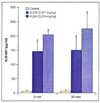Soluble epoxide hydrolase: a new target for cardioprotection
- PMID: 19333883
- PMCID: PMC2900160
Soluble epoxide hydrolase: a new target for cardioprotection
Abstract
Arachidonic acid is metabolized to a number of bioactive eicosanoid molecules by several enzymes, including enzymes of the COX, lipoxygenase and cytochrome P450 (CYP) monooxygenase pathways. Inhibition of the CYP omega-hydroxylase pathway, stimulation of the CYP-epoxygenase pathway and administration of exogenous epoxyeicosatrienoic acids resulted in cardioprotection in animal models of ischemia; contractile function was improved in mouse hearts subjected to global ischemia/reperfusion, and infarct size was reduced in canine and rat hearts. Cardioprotective effects were also achieved when metabolism of the endogenous epoxyeicosatrienoic acids (EETs) by their major enzymatic hydrolysis pathway was blocked in gene knockout mice (EPHX2-/-) or by inhibitors of soluble epoxide hydrolase (sEH), such as 12-(3-adamantan-1-yl-ureido)-dodecanoic acid (AUDA). Pretreatment of canine hearts with AUDA dose-dependently reduced infarct size, and AUDA enhanced the infarct-sparing effect of treatment with exogenous EETs. The preliminary results of studies in rodent hearts have also demonstrated that AUDA and AUDA-butyl ester reduce infarct size. These results and others obtained in models of myocardial stunning and hypertrophy suggest that inhibitors of EPHX2 or sEH have therapeutic potential in a broad range of cardiovascular diseases.
Figures



Similar articles
-
Soluble epoxide hydrolase inhibition and gene deletion are protective against myocardial ischemia-reperfusion injury in vivo.Am J Physiol Heart Circ Physiol. 2008 Nov;295(5):H2128-34. doi: 10.1152/ajpheart.00428.2008. Epub 2008 Oct 3. Am J Physiol Heart Circ Physiol. 2008. PMID: 18835921 Free PMC article.
-
Effects of the selective EET antagonist, 14,15-EEZE, on cardioprotection produced by exogenous or endogenous EETs in the canine heart.Am J Physiol Heart Circ Physiol. 2008 Jun;294(6):H2838-44. doi: 10.1152/ajpheart.00186.2008. Epub 2008 Apr 25. Am J Physiol Heart Circ Physiol. 2008. PMID: 18441205 Free PMC article.
-
Inhibition of soluble epoxide hydrolase does not protect against endotoxin-mediated hepatic inflammation.J Pharmacol Exp Ther. 2008 Dec;327(3):707-15. doi: 10.1124/jpet.108.142398. Epub 2008 Sep 24. J Pharmacol Exp Ther. 2008. PMID: 18815352 Free PMC article.
-
Soluble epoxide hydrolase inhibitors and heart failure.Cardiovasc Ther. 2011 Apr;29(2):99-111. doi: 10.1111/j.1755-5922.2010.00150.x. Cardiovasc Ther. 2011. PMID: 20433684 Free PMC article. Review.
-
Role of epoxyeicosatrienoic acids in cardiovascular diseases and cardiotoxicity of drugs.Life Sci. 2022 Dec 1;310:121122. doi: 10.1016/j.lfs.2022.121122. Epub 2022 Oct 26. Life Sci. 2022. PMID: 36309225 Review.
Cited by
-
The role of 14,15-dihydroxyeicosatrienoic acid levels in inflammation and its relationship to lipoproteins.Lipids Health Dis. 2013 Oct 23;12:151. doi: 10.1186/1476-511X-12-151. Lipids Health Dis. 2013. PMID: 24148690 Free PMC article.
-
Metabolism pathways of arachidonic acids: mechanisms and potential therapeutic targets.Signal Transduct Target Ther. 2021 Feb 26;6(1):94. doi: 10.1038/s41392-020-00443-w. Signal Transduct Target Ther. 2021. PMID: 33637672 Free PMC article. Review.
-
New Lipid Mediators in Retinal Angiogenesis and Retinopathy.Front Pharmacol. 2019 Jul 5;10:739. doi: 10.3389/fphar.2019.00739. eCollection 2019. Front Pharmacol. 2019. PMID: 31333461 Free PMC article. Review.
-
Discovery of Soluble Epoxide Hydrolase Inhibitors from Chemical Synthesis and Natural Products.J Med Chem. 2021 Jan 14;64(1):184-215. doi: 10.1021/acs.jmedchem.0c01507. Epub 2020 Dec 28. J Med Chem. 2021. PMID: 33369424 Free PMC article. Review.
-
Inhibition of Soluble Epoxide Hydrolase 2 Ameliorates Diabetic Keratopathy and Impaired Wound Healing in Mouse Corneas.Diabetes. 2018 Jun;67(6):1162-1172. doi: 10.2337/db17-1336. Epub 2018 Apr 3. Diabetes. 2018. PMID: 29615440 Free PMC article.
References
-
-
Rosamond W, Flegal K, Friday G, Furie K, Go A, Greenlund K, Haase N, Ho M, Howard V, Kissela B, Kittner S, et al. Heart disease and stroke statistics - 2007 update: A report from the American Heart Association Statistics Committee and Stroke Statistics Subcommittee. Circulation. 2007;115(5):e69–e171. • An excellent summary of the demographics of CVD in the US.
-
-
-
Murry CE, Jennings RB, Reimer KB. Preconditioning with ischemia: A delay of lethal cell injury in ischemic myocardium. Circulation. 1986;74(5):1124–1136. • The first paper to describe the phenomenon of IPC and the consequent reduction in infarct size in dogs.
-
-
-
zhao zQ, Corvera JS, Halkos ME, Kerendi F, Wang NP, Guyton RA, Vinten-Johansen J. Inhibition of myocardial injury by ischemic postconditioning during reperfusion: Comparison with ischemic preconditioning. Am J Physiol Heart Circ Physiol. 2003;285(2):H579–H588. • The first paper to describe the phenomenon of ischemic postconditioning during reperfusion and compare its efficacy with that of ischemic IPC.
-
-
-
Spector AA, Norris AW. Action of epoxyeicosatrienoic acids on cellular function. Am J Physiol Ceil Physiol. 2007;292(3):C996–C1012. • A thorough review of the cellular actions of the EETS in different organs.
-
Publication types
MeSH terms
Substances
Grants and funding
LinkOut - more resources
Full Text Sources
